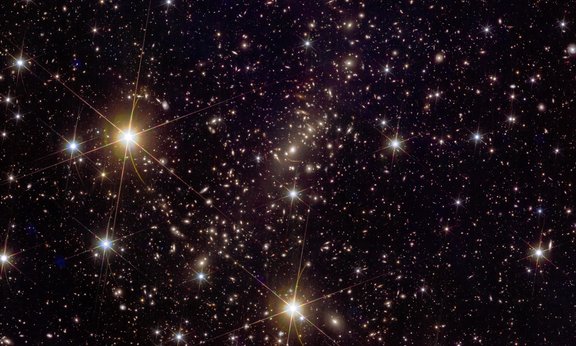
This picture is a small part from a bigger picture Euclid Image showing the galaxy cluster Abel 2390.
Launched last year, ESA offers space telescopes Euclid Data for almost one year. The first scientific results were published today. They show that the new instrument is capable of detecting a representative sample of all galaxies in the Universe. A study led by the University of Innsbruck has identified 600 previously unknown dwarf galaxies in the Perseus galaxy cluster.
The study, led by Francine Marleau at the Institute of Astrophysics and Particle Physics at the University of Innsbruck, identified a total of 1,100 dwarf galaxies in the Perseus galaxy cluster, 630 of which were previously undiscovered. Dwarf galaxies are more difficult to find because they are not very bright and their light is widely distributed across the sky. Francine Marleau’s team studied the structure and size of dwarf galaxies based on data from the Euclid Space Telescope and discovered star clusters around the galaxies. With the help of the discovered galaxies, the team was also able to determine the so-called luminosity function. “This activity can be understood as the result of a census,” explains Francine Marleau. “This indicates how many galaxies exist with a certain luminosity. With the newly discovered dwarf galaxies, we were able to extend our knowledge of this function significantly to ‘darker’ galaxies.”
In addition to the Perseus galaxy cluster, the nine Science papers just published also examined the Fornax galaxy cluster, where 5,000 new star clusters were found. “Galaxies have also been discovered in our ‘closest’ neighborhood,” says Laila Linge, a postdoctoral researcher and project leader in the Institute for Astrophysics and Particle Physics. “In astronomical terms, even closer is between 1.6 and 29.7 million light-years from Earth.” There, the telescope can take pictures of individual stars and scientists can classify different star populations.
In the path of dark matter
Galaxy clusters contain a lot of dark matter. Their mass distorts the observed shapes of distant background galaxies through gravitational lensing. Tim Schraback, head of the research group at the Institute of Astrophysics and Particle Physics, analyzed the dark matter of the Abel 2390 galaxy cluster with an international team, “Our study shows how well suited the new instrument is for this analysis,” says Tim Schraback happily. “By deconstructing the shapes of the background galaxies, we were able to measure the distribution of dark matter in and around the galaxy cluster.”
The new results demonstrate the strength of the Euclid telescope: “The new instrument can simultaneously observe a large area of the star-filled sky, thereby providing a representative sample of all galaxies,” says Laila Link. “Due to the high sensitivity to surface brightness, we also see dwarf galaxies and more diffuse galaxies. With particularly sharp images due to the high spatial resolution, we can identify dwarf galaxies, while also finding and classifying so-called nuclear star clusters and globular star clusters.
A new tool of science
Space Telescope Euclid European Space Agency ESA Launched nearly a year ago, on July 1, 2023, and intended to create the largest 3D map of space to date. Scientists hope this will help them learn more about the universe’s hitherto unexplored dark matter and dark energy. Euclid’s data are evaluated by the International Euclid Consortium. The 1.2 meter diameter space telescope is expected to create the largest and most accurate 3D map of the universe and observe billions of galaxies in the next few years. Using this diagram, Euclid was able to reveal how the universe expanded after the Big Bang and how the structures in the universe developed. This will provide scientists with additional clues to better understand the role of gravity and the nature of dark energy and dark matter. The Euclid Consortium — made up of 2,000 scientists at 300 research institutions in 15 countries — evaluates the work data. Data are supplemented with ground-based telescopes. The research groups of Tim Schrabach and Francine Marleau at the University of Innsbruck have been significantly involved in the project.
